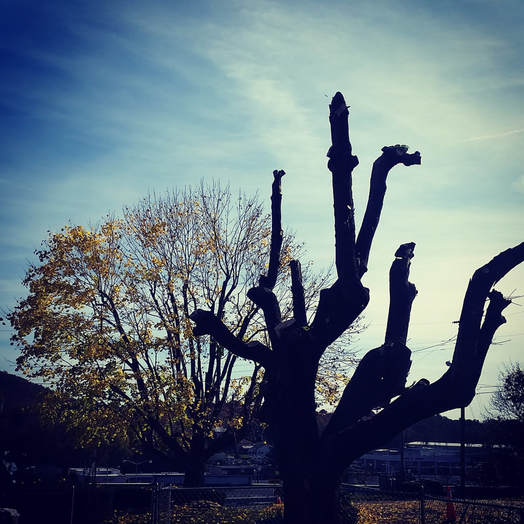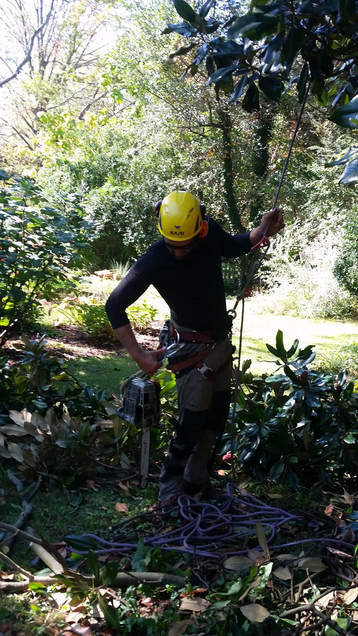Jason LaRoseCertified Arborist, CTSP, owner Queen City Silviculture  If I ask you to picture a tree what image comes to mind? A majestic white oak (Quercus Alba) in the Winter? Maybe a dogwood (Cornus florida) flowering in the early Spring? Or rather a row of crape myrtles (Lagerstroemia sp.) in the shimmering Summer heat? Perhaps the one nearest to my heart, a blazing sugar maple (Acer saccharum) in the crisp Fall? Trees come in endless varieties of shapes, sizes, colors and smells. I doubt that any of you brought to mind a picture of a tree that has been “topped”. We have all seen an example of this poor excuse for tree “care” before, haven’t we? So what's the deal? “Topping” is the common name for make a heading cut throughout the crown of a mature tree, usually carried out on the deciduous hardwoods that grow so well here in the east. According to the Urban Tree Foundation a heading cut made in this way; “Reduces the length of the stem or branch back to a point without regard to the position or diameter of the nearby lateral branches.” I would add without regard to the tree as a whole as well. I’ll take a moment to make a distinction between the aforementioned practice and a reduction cut. A reduction cut is performed by cutting back to a lateral branch not less than ⅓ the size of the parent stem. This is to ensure that the limb has the available resources to carry on its life processes of growth and defense. We also take into account the gross volume of material being removed from the tree. Never to exceed 20% in a given year. Again many factors are involved when making a determination on what to remove and leave during proper pruning, including safety, aesthetics, tree response etc. Any time I have talked to someone that has had a tree topped, or have been approached by a person that would like me to top their tree, I find one thing in common. FEAR. They are afraid. To be fair, I might be afraid too, if I didn't understand tree mechanics, bioengineering, and I was looking up at a monstrous northern red oak (Quercus rubra) arching over my house where my family sleeps at night. Trees have evolved over nearly 200 million years to withstand, wind, rain, drought, insects, bacteria, fungi, and GRAVITY. They have yet to find a way to repel human ignorance. It is our job as Arborists to constantly educate ourselves and the folks we encounter about trees and the greater forces at work in the natural world. Trees start growing in the Spring at the extreme ends of the terminal buds. As these open, extend and “harden off” the scaffold branches fire up, swell and strengthen to support the increased weight and length. As Spring turns to summer the procession continues, down into the large upright leaders, encapsulating the new wood and supporting the new growth. Next, the trunk swells, and adds a new layer around the base of those branch collars like the finest mortise and tenon construction. Anyone who's ever split wood knows how tough these spots are, right? As Summer wanes to Fall, the magic continues in the lower extremities, anchoring this new tree to the ground through the incredibly strong buttress roots. Because you see, if a tree is in its 100th Summer, there are 99 trees still present underneath. Topping does not take any of this into account. Heading cuts sever through all of those individual trees and the results are disastrous for the specimen. Here is what follows in a nutshell: The tree goes into survival mode and uses all or most of its energetic reserves to push out new growth in a valiant attempt to survive. Meanwhile it has no energy for defense against the wood decay organisms that have just attached themselves to all of the newly opened wounds. Some species especially maples and elms appear to do pretty well by the next year or so. These families of trees grow rapidly and at first glance don’t seem “too bad”. In fact they may even be a candidate for restructuring in about 5 or 10 years. This is a pruning practice in which a previously topped tree is judiciously thinned by an experienced Arborist to help recall some of its former glory. However these trees will always have large decay pockets, sun scalding on the branches that were left originally, and be more hazardous in the long run because the new growth always attaches poorly to the main stem. In fact, I had a limb rip out on me during a thinning and restructuring operation a few years ago and if I hadn’t been secured with a secondary point of attachment may have fallen to the ground. (hashtag backups!) Trees in the landscape do require regular attention. They have evolved over time to grow tightly together in the forest with very little sun, waiting for their chance to reach up to the top floor of the canopy. Out in the yard they go “sun crazy” and do not typically have ideal structure especially if allowed to grow for 30 years before an expert is called. The trained Arborist’s loving hand saw will make all the difference for the tree and your peace of mind. “The true meaning of life is to plant trees, under whose shade you do not expect to sit.” -Nelson Henderson
2 Comments
Jason LaRose So what is an arborist anyway? If you answered that with some degree of satisfaction, then maybe you can answer this: what is arboriculture? Maybe I should start with a few things that arborists (those who are skilled in the art of Arboriculture) are NOT. First of all, we are not tree trimmers. Trimming is something you do with a weed eater or to your finger nails. Arborists never trim, we prune. If someone says they want to trim your tree, extricate yourself from the conversation ASAP. I don't care if they have a really nice ladder that goes really high and they’ve been “cuttin” trees down for a really long time. Ladders are bad enough without a chainsaw… I digress. Arborists are also not foresters. We don't clear cut large tracts of land to make money off the timber. True, we use some of the same tools, and yes, we can fell big trees with the best of them, but can the forester sneak that tall skinny maple between the garage and the fence? Maybe. Does he employ ropes, pulleys and working knowledge of geometry and physics to safely bring the specimen down without hitting nearby targets? Maybe, maybe not. These guys work in the woods. As long as they know where their buddies are before making that cut, its all good, right? And what if the tree cannot be felled from the ground? This is very often the case and scenarios we arborists see everyday. Has the forestry industry trained its workers to safely ascend the tree, dismantle it, lower it piece by piece to the ground over top of your brand new shingle roof, without anything but sawdust landing on it? I think not. What I am getting at here is that Arboriculture and the men and women who make it happen out there every day are “specialists”, highly trained, highly motivated, intelligent, miracle workers. Not kidding. Finally, we are not line clearance workers. These folks are trained to keep the utility lines free from impeding branches. They perform a valuable service, and here in the eastern deciduous forest region of North America, they are kept busy. True, the cuts on the trees are usually ragged, and the trees themselves often look like Edward Scissorhands had a bad day. This is for several reasons, First the folks doing the work are contracted to cut anything closer than 10’ from the line. Period. They are not trained in making proper pruning cuts because the goal here is not a beautiful healthy tree, it is to keep the lights on. Another reason is the species of tree growing under the lines. Planting a Norway Maple which has the genetics to grow 60-80 feet tall under a power line that is 40 feet off the ground is not advised. Pick a smaller variety. There are plenty to choose from. So, next time you meet an arborist and you're tempted to ask if he works for Asplundh, maybe pass on that one. But, if you think to ask if he’s been in any cool trees lately, you will have a friend for life. |
AuthorJason and Danielle LaRose Archives
April 2024
|
 RSS Feed
RSS Feed